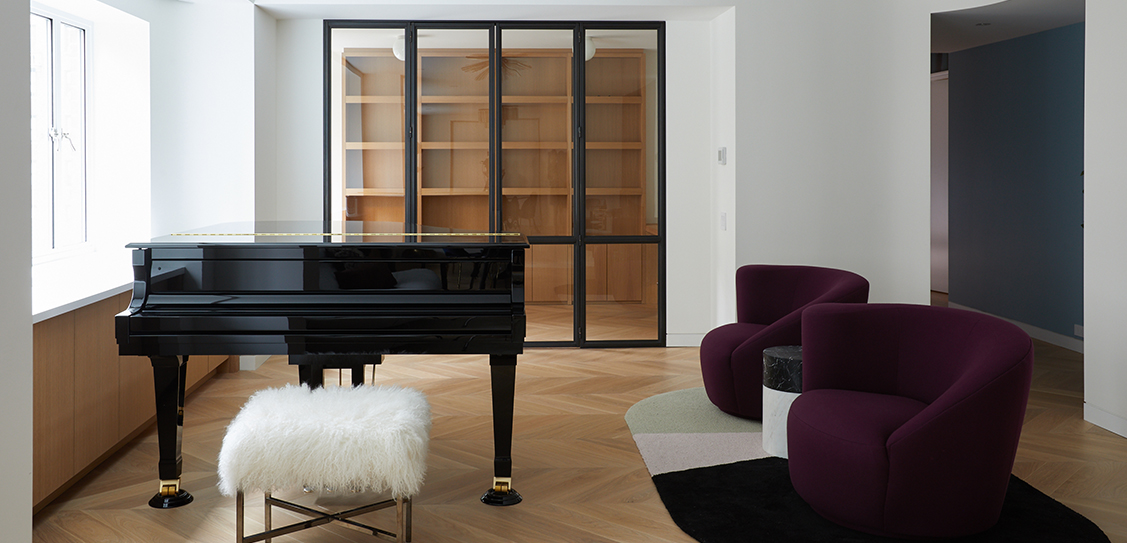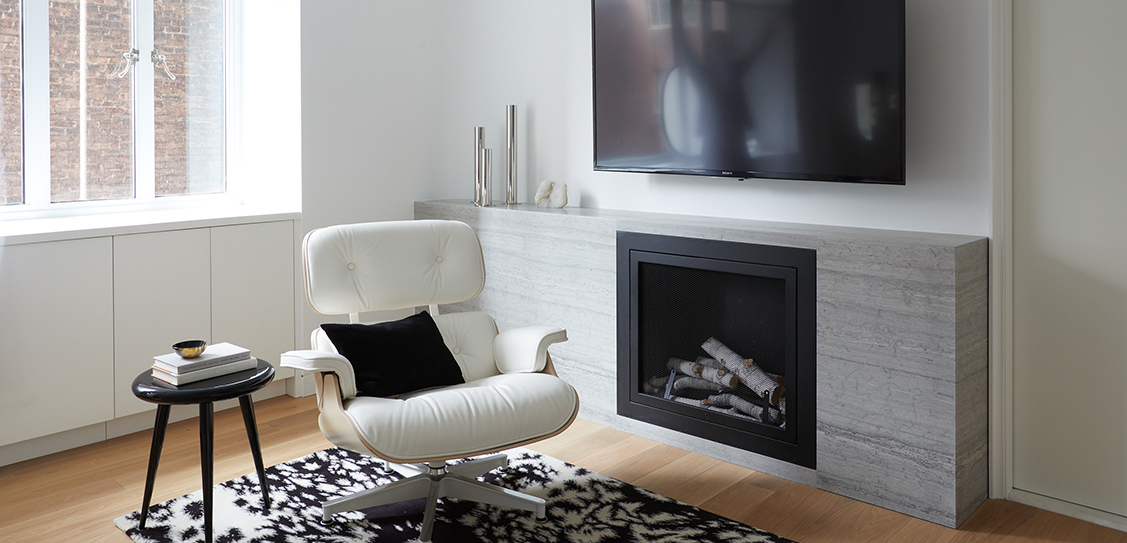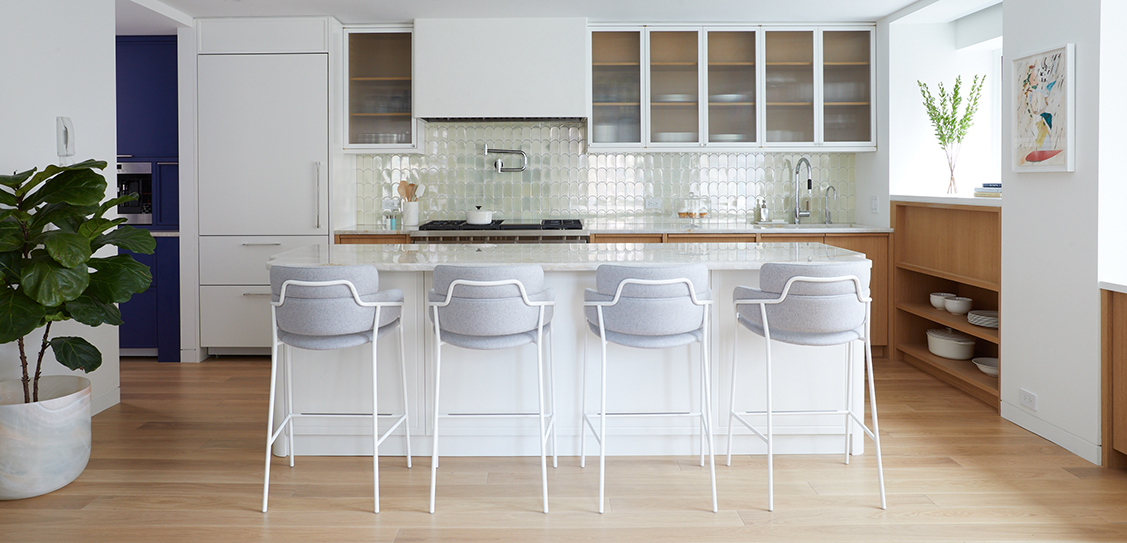The 3,400 sq ft home, a combination of two units on the sixth floor of an Upper East Side post-war co-op building, marks the clients’ first foray into a full renovation, with their varied lifestyle dictating the overarching floor plan.
Both parents occasionally worked from home and needed a study. Yet, it was important to have an open space for entertaining with the option to close off areas for playdates.
The residence occupies the full length of the building with eight windows creating a north-to-south view of Lexington Avenue. Inspired by a 70s open floor plan, the firm opted for a layout where rooms flow into one another. Walls were removed to create a series of bays, defined by the building’s original structural columns. Rounded corners were added to each bay, further smoothing the transition between rooms.
Large pocket and custom steel and glass doors create a flexible, spacious environment. When open, the home reads as a long floor-through with light pouring into the shared space, perfect for a party. When closed, the study and the combined family room and kitchen can be separated from the other functioning zones, music room, sitting room, and formal dining room.
The interiors scheme draws from the client’s desire to fuse a mid century aesthetic with old world glamour.
[She] loved anything in black and white, navy or purple, and a little sparkle and glamour. In contrast, she appreciated a clean aesthetic and modern lines. The result is a fusion of the 70s open-plan concept, Deco opulence and materiality, and mid century Iconography.
Materials were luxe and prolific, their characteristics driving the overall design. Defining surfaces include a range of veined marbles and quartzites; ivory toned Venetian plaster, warm white oak, opalescent tiles, and polished metals. Richly hued velvets in shades of ink deep blues, purples, and blacks, also feature prominently.
The home’s foyer sets the material palette for the apartment. A stunning black-and-white stone tile floor from Ann Sacks is set in a custom Art Deco geometric pattern with a basket weave of brass inlay, while a 70s travertine and brass console by Jean-Charles Moreux complements the floor’s rich luster and patterning.
The clients wanted an impressive foyer that diverted from the chevron oak throughout the apartment.
The foyer leads directly to the home’s common areas, the sitting room, kitchen and dining area, music room, and study. A wall-length fireplace hewn in deep brown quartzite with white and umber veining anchors the sitting room. Above, custom millwork painted in Benjamin Moore Espresso Bean blends with the hearth and conceals a television while maintaining the aesthetic of a grand wall. Dan Johnson Viscount chairs in a silvery blue-grey velvet with brass details frame the fireplace.
In the adjoining formal dining room, a 70s JT Kalmar Austrian tiered chandelier with Venini smoked and clear glass becomes the focal point, and hovers above a Saarinen Nero Marquina table and suite of plush, sapphire-blue Saarinen chair with legs plated in 14k gold. A wet bar accents the room and is fitted with a tiny copper sink, built-in glass shelves, a rose-coloured mirror, and a hidden wine fridge. This leads to a sitting area where hexagonal lounge chairs and an ottoman from the 70s were redesigned in two-tone Knoll velvet. In the adjacent breakfast room, Danish teak chairs from the 1960s are an informal match to a gold-plated Platner glass table, while kitchen counters are clad Cristallo Quartzite with glittery, opalescent depth.
In the music room, Art Deco-inspired Kelly Wearstler nickel Strada flush mount adds shine above the piano and Vladimir Kagan Corkscrew chairs in aubergine Knoll wool become a conversation nook leading to the study. Steel-and-glass framed doors in the study offer privacy for work-from-home days, but continue the apartment's extensive length. Fabricated by Habiterra, the grid of four glass panels mirrors the symmetry of the study’s custom libraryshelving. Charlotte Perriand chairs accent the study and are upholstered in white leather.
A curved hallway with Flat Vernacular Emerald City wallpaper separates the main living space from the bedroom and dressing areas, and is accented with a 20s Art Deco brass flush mount light fixture and an Italian metal wall sculpture from Artemest.
Highlights in the home’s bedroom wing include a custom tufted headboard that wraps the master bedroom’s curved wall. Geiger material with irregular heavy yarn, reminiscent of a Chanel tweed, adds dimension to the headboard, while 70s French lacquered- and chrome-nightstands in black nestle into its plush surface. To fulfill the client’s dream of the perfect dressing room, the firm designed custom mirrored millwork with a vanity and built-in tufted velvet bench. The room glows with recessed lights positioned at the foot of the closets, while 60s Swedish silk tasseled sconces designed by Hans-Agne Jakobsson flank the vanity mirror. All this is rooted in a soft-grey marble checkerboard floor. Adjacent, the master bath features Striatto Vision Marble surfaces.
She was inspired by a vintage 60s image from Knoll, complete with Saarinen furniture and playful patterns.
B. Reyes, Director of Design for Interiors, FTAThe architects designed a queen platform bed, large enough for a sleepover, along with surrounding seating areas that accommodate both study and play. A custom Maharam leather and Paul Smith polka dot and plaid cushion offset a geometric wallpaper and cover hidden storage underneath. A sloth, the client daughter's favorite animal, became a playful motif in the room, presented boldly in a custom light fixture fabricated by Lite Brite Neon Studios.
The home’s most unique room, a bathroom-meets-dog spa, caters to the client’s canines. The space hosts a tall but shallow shower and sink area, perfect for pet bath time. Even here, the home’s Art Deco theme prevails; a basket weave mosaic with Carrera and Nero Marquina cladding the floor, nodding to classic NYC pre-war co-op bathrooms.



